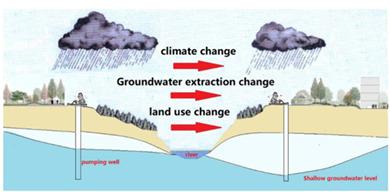当前位置:
X-MOL 学术
›
Hydrol. Process.
›
论文详情
Our official English website, www.x-mol.net, welcomes your
feedback! (Note: you will need to create a separate account there.)
Quantitative analysis of the driving factors for groundwater resource changes in arid irrigated areas
Hydrological Processes ( IF 2.8 ) Pub Date : 2020-11-07 , DOI: 10.1002/hyp.13967 Chenyu Guo 1, 2, 3, 4, 5 , Tie Liu 1, 2, 3, 5, 6 , Yaxuan Niu 1, 2, 3 , Zhibin Liu 1, 2, 3 , Xiaohui Pan 1, 2, 3 , Philippe De Maeyer 4, 5, 6
Hydrological Processes ( IF 2.8 ) Pub Date : 2020-11-07 , DOI: 10.1002/hyp.13967 Chenyu Guo 1, 2, 3, 4, 5 , Tie Liu 1, 2, 3, 5, 6 , Yaxuan Niu 1, 2, 3 , Zhibin Liu 1, 2, 3 , Xiaohui Pan 1, 2, 3 , Philippe De Maeyer 4, 5, 6
Affiliation

|
How to quantify the impact of climate change and human activities on groundwater is not only a hot topic of current research but also a key point of water resource management in arid irrigated areas. Therefore, this paper analyzes the changes in the trends of land use, climate, and groundwater extraction in the Yanqi Basin in recent years and uses the distributed hydrological model MIKE‐SHE to quantitatively analyze the impacts of these three factors on groundwater resources. The results show that: 1. The Nash coefficients of the simulated and observed groundwater levels during the verification period are 0.84, 0.79 and 0.76; the correlation coefficient between the simulated and observed soil moisture is 0.86. Although there are some uncertainties in the simulation, the results prove that the model can be used to simulate arid irrigated areas. 2. The effects of these three factors on groundwater levels are 5, 12.5 and 82.5%, respectively, and have caused the regional average groundwater level to decrease by a maximum of 0.07, 0.23 and 1.79 m, respectively. The effects of these three factors on the interactions between surface water and groundwater were 7.04, 3.63 and 89.33%. Groundwater extraction has become the main influencing factor of regional groundwater resources changes due to its more direct influence. 3. The influence of groundwater extraction has a strong spatial distribution characteristic and 10% of the study area has been greatly impacted by the groundwater extraction. Base on the above results, integrating multidisciplinary knowledge to establish the relationship between ecological environment and groundwater changes can provide strategies for the sustainable development of groundwater.
中文翻译:

干旱灌区地下水资源变化驱动因素的定量分析
如何量化气候变化和人类活动对地下水的影响,不仅是当前研究的热点,还是干旱灌溉地区水资源管理的重点。因此,本文分析了qi县盆地近年来土地利用,气候和地下水开采趋势的变化,并使用分布式水文模型MIKE-SHE定量分析了这三个因素对地下水资源的影响。结果表明:1.验证期内模拟和观测地下水位的纳什系数分别为0.84、0.79和0.76。模拟和观测的土壤水分之间的相关系数为0.86。尽管模拟中存在一些不确定性,但结果证明该模型可用于模拟干旱灌溉区域。2。这三个因素对地下水位的影响分别为5、12.5和82.5%,并导致区域平均地下水位分别下降最大0.07、0.23和1.79 m。这三个因素对地表水与地下水相互作用的影响分别为7.04、3.63和89.33%。地下水开采由于其更为直接的影响,已成为区域地下水资源变化的主要影响因素。3.地下水提取的影响具有很强的空间分布特征,并且研究面积的10%受地下水提取的影响很大。根据以上结果,
更新日期:2021-01-13
中文翻译:

干旱灌区地下水资源变化驱动因素的定量分析
如何量化气候变化和人类活动对地下水的影响,不仅是当前研究的热点,还是干旱灌溉地区水资源管理的重点。因此,本文分析了qi县盆地近年来土地利用,气候和地下水开采趋势的变化,并使用分布式水文模型MIKE-SHE定量分析了这三个因素对地下水资源的影响。结果表明:1.验证期内模拟和观测地下水位的纳什系数分别为0.84、0.79和0.76。模拟和观测的土壤水分之间的相关系数为0.86。尽管模拟中存在一些不确定性,但结果证明该模型可用于模拟干旱灌溉区域。2。这三个因素对地下水位的影响分别为5、12.5和82.5%,并导致区域平均地下水位分别下降最大0.07、0.23和1.79 m。这三个因素对地表水与地下水相互作用的影响分别为7.04、3.63和89.33%。地下水开采由于其更为直接的影响,已成为区域地下水资源变化的主要影响因素。3.地下水提取的影响具有很强的空间分布特征,并且研究面积的10%受地下水提取的影响很大。根据以上结果,











































 京公网安备 11010802027423号
京公网安备 11010802027423号